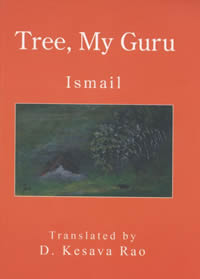During a satisfying kvetching session with friends in Atlanta last weekend — you know, the usual — about how the world does not run according to my ideas, I idly picked up the book “Tree, My Guru”, a translation of Ismail’s poems by D. Kesava Rao, with an introduction by Tammineni Yadukula Bhushan. My host, in a futile attempt to divert me, challenged me to write a review of that book. In my boundless hubris I agreed and borrowed the book to read on the flight home.
First impressions first: I loved the layout of the book. I loved that I could read the original and compare it to the translation. I loved reading Ismail after all these years.

Tree, My Guru
Available from
desibooks AT gmail DOT com
for $12.00.
Now moving on to the hard task of critiquing what is obviously a labor of love, I am left to wonder who the audience could be for this book: the poetry lovers among the native English readers, Or, the Indian readers from other languages with English knowledge? If it is former, then the translation misses the mark. If it is the latter, it, perhaps, is adequate. That is, the translation uses language poorly for a native speaker.
Let us look at the poems in this collection, which vary from brilliant to sophomoric. Some are gems, with Ismail’s unique brand of precision: aatma hatya, paaTa, and parts of daaham. Some are formulaic: pikaasO (the poem “rembraanDT“, on the contrary is great!), vaana gu~r~ram, and sRshTi. Some are tired old songs: sanja naarinja, and isukalO veeLLu. Some break rules without achieving poetic impact, like “Left bank, Paris” with its cliched ending and unsymmetrical middle. Some, like sooryuni chEpa, are praasa kreeDalu, which are better done in the hands of other poets. The translation also has the same quality, uneven with patches of brilliance.
Let us get the worse part of the book out of the way: The prose introducing the book – both the preface and the introduction – does disservice to the poetry in the book. Like most amateur efforts, there are grammar mistakes, rhetorical errors, and overwrought sentences. A precise poet like Ismail deserves better introduction. At least the current introduction serves one function: when it boasts, in rhetorically challenged prose that Ismail is one of the world’s best, we do not take it seriously – and that is good.
From then on, it gets better. The first translation was perhaps one of the best. Consider how a phrase like dharanu chochchi, divini vichchi gets translated to “probing the earth and spanning the sky”. Instead of obsessing with the accuracy, the translator got three things right: image, cadence, and the register. See for yourself. The original is:
“పురుగు సగం, సగం పిట్ట
ధరను చొచ్చి, దివిని విచ్చి
విరులు తాల్చు తరువు”, … and it becomes
“Part worm, part bird,
the tree,
probing the earth and spanning the sky
gets crowned with flowers”
You could see similar constructions throughout the book, where the translator dared to trust himself to break out of the tyranny of the accuracy in translation. There are few other places where such independence is in display. For instance when the translator writes about “thirst’s prickly palm blooming” in his throat, it is close enough to original, yet independent to preserve the sense.
Alas, looks like the translator did not trust him often enough. When the original reads like a sharply drawn minimalistic picture, the translation feels like a caricature. Consider the following poem.
“How can you sing,
O stream
that interminable murmuring song?
Look, how can I stop singing
— my life is full of stones”
In fact, the translator confesses in the appendix that he was unhappy with the second part of the poem, because he had to invert the sentences from the original. From what I read, it is the exactly the opposite. The second part captured the semantics of the original well. It is the first part that stands on stilts (and falls) with no poetry in those words. Now read the original in complete:
“సెలయేరా, సెలయేరా!
గలగల మంటో నిత్యం
ఎలా పాడగలుగుతున్నావు?
చూడు, నా బతుకునిండా రాళ్ళు
పాడకుంటే ఎలా?”
How much does the usage of “O Stream” miss the tenderness of calling a stream with selayEraa, selayEraa? It is not that there is no precedence –- think “O city, city. Sometimes I hear the pleasant sounds of …”. nityam, which is such a positive word, fresh as a pearl, becomes “interminable” which reminds me of a beast in horror movies that cannot be killed.
There are other places where the translator is tone-deaf to the words and its usage. Readers in the know cringe when baaku becomes a rapier, or a medicine becomes a “simple”. vippukunna becomes “gaping” (which always has a hole associated with it, and this case is inappropriate). Almost every other poem has a couple of words that are words that miss the mark. To be fair, roopaka samaasam translates poorly into English. How would you translate prapanchapu mullu into English?
Even with all these kind of problems, it is hard not to like Ismail, even in poor translation. After reading so much about Rembrandt in several art books and seeing his works in the museum, I was stuck by the originality and accuracy of the poem “rembraanDT“, which, a translation cannot hide. Here too, the translator uses a wrong word: he uses ‘lacerate’ to substitute for deliberate, precise gaaTlu. It not only is inaccurate, it also misses the nuance in the original.
That aptly summarizes the translation — loss of precision of a precise poet. But, then, how does one capture that essence of a poem and translate it into a different weltanschauung?
